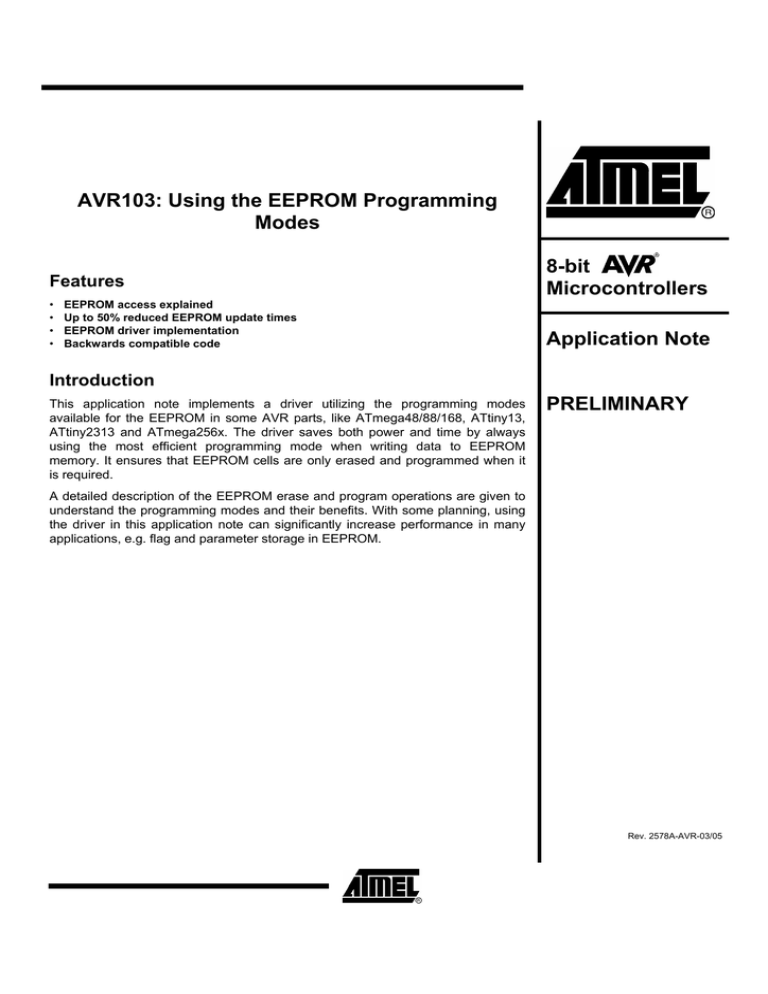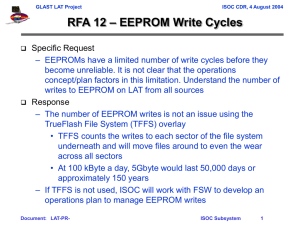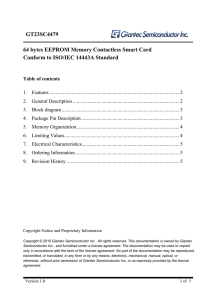
AVR103: Using the EEPROM Programming
Modes
Features
•
•
•
•
EEPROM access explained
Up to 50% reduced EEPROM update times
EEPROM driver implementation
Backwards compatible code
8-bit
Microcontrollers
Application Note
Introduction
This application note implements a driver utilizing the programming modes
available for the EEPROM in some AVR parts, like ATmega48/88/168, ATtiny13,
ATtiny2313 and ATmega256x. The driver saves both power and time by always
using the most efficient programming mode when writing data to EEPROM
memory. It ensures that EEPROM cells are only erased and programmed when it
is required.
PRELIMINARY
A detailed description of the EEPROM erase and program operations are given to
understand the programming modes and their benefits. With some planning, using
the driver in this application note can significantly increase performance in many
applications, e.g. flag and parameter storage in EEPROM.
Rev. 2578A-AVR-03/05
Theory of Operation
EEPROM Access
Explained
EEPROM memory consists of independent cells each representing a single bit. The
cells are based on floating-gate transistor technology: An electrical charge trapped on
the transistor gate determines the logic level of the cell. Slightly simplified, the way
that the cell works can be described as follows: When erasing a cell, a charge is
placed on the gate and the cell is read as logic one. Programming a cell is equivalent
to discharging the gate, bringing the logic value to zero. It is only possible to program
(discharge) a cell that has been erased (charged).
Note that even if EEPROM memory is accessed in bytes, bits can be programmed
individually. Since only the bits being programmed are discharged (zero), the
remaining unprogrammed bits are still charged (one). Any unprogrammed bit can be
programmed at a later stage. Therefore, programming a byte that is already
programmed, without erasing in between, will result in a bit-wise AND between the
old value and the new value.
EEPROM Programming
Modes
In AVR devices that don’t have selectable EEPROM programming modes, the ‘write’
operation is actually a combined erase and program operation. The memory byte to
be written is always erased before programming the new value, even if no bits need
to be erased. For instance, when programming the value 0x00 to an EEPROM byte
already containing the value 0x0F, there is no need to erase the byte first. No bits
need to be changed from 0 to 1. The erase operation in this case has no effect except
consuming time and power. The combined erase and program operation takes twice
the time of a simple program operation.
When designing with AVR devices that do have selectable EEPROM programming
modes, e.g. ATmega48/88/168, it is possible to split the EEPROM write access into
separate erase and program operations. This will reduce EEPROM update time by
50% in cases where an erase is not required. The available programming modes are
listed in Table 1 below.
In this document the word ‘program’ is used to describe update without erase, and
‘update’ is used for any operation that changes EEPROM contents.
Table 1. EEPROM Programming Modes
Programming Mode
Resulting operation
Typical update time
0
Combined erase and program
3.4 ms
1
Erase only
1.8 ms
2
Program only
1.8 ms
The programming mode is set using the EEPM1 and EEPM0 bits of the EEPROM
Control Register (EECR). The default mode at startup is mode 0, and the register is
therefore compatible with software not using EEPROM programming modes.
Efficient EEPROM
Access
To benefit from the programming modes, the EEPROM software should use the
modes so that only the required operation is performed. For instance, when updating
an EEPROM byte, and no bits need to be changed from 0 to 1, an erase is not
necessary.
When updating EEPROM bytes, the software should compare the bits of the existing
value against the bits of the new value and decide which programming mode to use.
Depending on the values written, the extra CPU cycles used to decide which mode to
use is outweighed by the reduction in average update time.
2
AVR103
2578A-AVR-03/05
AVR103
Implementation
This application note provides a small test application to show how to use the
programming modes. The source code implements EEPROM read and update
functions and executes a number of EEPROM updates to demonstrate the different
programming modes. Only the EEPROM update function is described in detail.
Refer to the document “source.doc” supplied with the code for source documentation.
The EEPROM_PutChar()
function
This is the EEPROM update function. It compares the old and new bytes and uses
the most efficient programming mode for the update operation. The flowchart is
shown in Figure 1 below.
Figure 1. EEPROM_PutChar flowchart
Write EEPROM
byte
Store old state and disable
global interrupts
Wait for any EEPROM
operations to finish
Wait for any SPM
operations to finish
Setup EEPROM address and
data registers
Get bit difference mask
(XOR old EEPROM value
with value to be written)
Any bits need
to be erased?
(AND difference mask
with new value)
No
Any bits need to
be programmed?
(new value different
from 0xFF?)
Any bits need
to be programmed?
(difference mask )
Yes
Start EEPROM write operation
Yes
No
Yes
Start EEPROM erase
operation
Start EEPROM combined
erase and write operation
No
Restore global interrupt
flag state
Return
An alternative approach would be to perform a bitwise AND on the old and new
values. If the result is equal to the new value, only a program operation is required. If
different, use combined program and erase mode. This would save some CPU cycles
3
2578A-AVR-03/05
and code size, but would not benefit from the cases when old and new values are
equal, or when only an erase operation is required.
Execution times
For the most general case Flash self-programming operations are considered in the
implementation. However, using the C compiler #define directive, the part of the
code regarding SPM can be left out. Refer to the commented source code for more
details.
In Table 2 below, the execution times for the general case is shown. The execution
times for the maximum speed optimization settings are also shown. The values
include the function call and return instructions and assume previous EEPROM and
SPM write was finished. The ‘Old EEPROM write’ operation refers to the standard
EEPROM write routine not using programming modes, which can be found as
examples in the datasheets.
Table 2. Execution times
Operation
No optimization(1)(2)
Max speed optimization(1)(2)
Erase only
41
35
Write only
41
35
Erase & write
41
35
No operation
36
30
Old EEPROM write
26
24
Notes:
Using
EEPROM_PutChar() in
your own applications
1: Values assume previous EEPROM and SPM write was finished.
2: For total execution time refer to values in Table 1.
This implementation of EEPROM_PutChar can replace existing implementations that
do not use programming modes. The function takes care of selecting the best
programming mode internally. For instance, the application note AVR104 “Buffered
Interrupt Controlled EEPROM Writes” can be enhanced to use programming modes
by replacing the two “Set EEPROM…” blocks in AVR104’s Figure 4 with the
EEPROM_PutChar code from this application note.
In many applications, significant benefits can be gained by carefully planning the way
the EEPROM is used. You should try to avoid changing bits from 0 to 1 if you can.
For instance, parameter storage in EEPROM can be enhanced with circular buffers in
the same way as Flash memory is utilized in application note AVR105 “Power
Efficient High Endurance Parameter Storage in Flash Memory”. Flash memory cell
erasing and programming are very similar to EEPROM cells.
Literature References
• ATmega48/88/168 Datasheet (Rev. C)
• Application Note AVR104: Buffered Interrupt Controlled EEPROM Writes
• Application Note AVR105: Power Efficient High Endurance Parameter Storage in
Flash Memory
• “Application-Specific Integrated Circuits” by Michael John Sebastian Smith
4
AVR103
2578A-AVR-03/05
Disclaimer
Atmel Corporation
2325 Orchard Parkway
San Jose, CA 95131, USA
Tel: 1(408) 441-0311
Fax: 1(408) 487-2600
Regional Headquarters
Europe
Atmel Sarl
Route des Arsenaux 41
Case Postale 80
CH-1705 Fribourg
Switzerland
Tel: (41) 26-426-5555
Fax: (41) 26-426-5500
Asia
Room 1219
Chinachem Golden Plaza
77 Mody Road Tsimshatsui
East Kowloon
Hong Kong
Tel: (852) 2721-9778
Fax: (852) 2722-1369
Japan
9F, Tonetsu Shinkawa Bldg.
1-24-8 Shinkawa
Chuo-ku, Tokyo 104-0033
Japan
Tel: (81) 3-3523-3551
Fax: (81) 3-3523-7581
Atmel Operations
Memory
2325 Orchard Parkway
San Jose, CA 95131, USA
Tel: 1(408) 441-0311
Fax: 1(408) 436-4314
Microcontrollers
2325 Orchard Parkway
San Jose, CA 95131, USA
Tel: 1(408) 441-0311
Fax: 1(408) 436-4314
La Chantrerie
BP 70602
44306 Nantes Cedex 3, France
Tel: (33) 2-40-18-18-18
Fax: (33) 2-40-18-19-60
ASIC/ASSP/Smart Cards
Zone Industrielle
13106 Rousset Cedex, France
Tel: (33) 4-42-53-60-00
Fax: (33) 4-42-53-60-01
RF/Automotive
Theresienstrasse 2
Postfach 3535
74025 Heilbronn, Germany
Tel: (49) 71-31-67-0
Fax: (49) 71-31-67-2340
1150 East Cheyenne Mtn. Blvd.
Colorado Springs, CO 80906, USA
Tel: 1(719) 576-3300
Fax: 1(719) 540-1759
Biometrics/Imaging/Hi-Rel MPU/
High Speed Converters/RF Datacom
Avenue de Rochepleine
BP 123
38521 Saint-Egreve Cedex, France
Tel: (33) 4-76-58-30-00
Fax: (33) 4-76-58-34-80
1150 East Cheyenne Mtn. Blvd.
Colorado Springs, CO 80906, USA
Tel: 1(719) 576-3300
Fax: 1(719) 540-1759
Scottish Enterprise Technology Park
Maxwell Building
East Kilbride G75 0QR, Scotland
Tel: (44) 1355-803-000
Fax: (44) 1355-242-743
Literature Requests
www.atmel.com/literature
Disclaimer: The information in this document is provided in connection with Atmel products. No license, express or implied, by estoppel or
otherwise, to any intellectual property right is granted by this document or in connection with the sale of Atmel products. EXCEPT AS SET
FORTH IN ATMEL’S TERMS AND CONDITIONS OF SALE LOCATED ON ATMEL’S WEB SITE, ATMEL ASSUMES NO LIABILITY
WHATSOEVER AND DISCLAIMS ANY EXPRESS, IMPLIED OR STATUTORY WARRANTY RELATING TO ITS PRODUCTS INCLUDING,
BUT NOT LIMITED TO, THE IMPLIED WARRANTY OF MERCHANTABILITY, FITNESS FOR A PARTICULAR PURPOSE, OR NONINFRINGEMENT. IN NO EVENT SHALL ATMEL BE LIABLE FOR ANY DIRECT, INDIRECT, CONSEQUENTIAL, PUNITIVE, SPECIAL OR
INCIDENTAL DAMAGES (INCLUDING, WITHOUT LIMITATION, DAMAGES FOR LOSS OF PROFITS, BUSINESS INTERRUPTION, OR
LOSS OF INFORMATION) ARISING OUT OF THE USE OR INABILITY TO USE THIS DOCUMENT, EVEN IF ATMEL HAS BEEN ADVISED
OF THE POSSIBILITY OF SUCH DAMAGES. Atmel makes no representations or warranties with respect to the accuracy or completeness of
the contents of this document and reserves the right to make changes to specifications and product descriptions at any time without notice.
Atmel does not make any commitment to update the information contained herein. Atmel’s products are not intended, authorized, or warranted
for use as components in applications intended to support or sustain life.
© Atmel Corporation 2005. All rights reserved. Atmel®, logo and combinations thereof, AVR®, and AVR Studio® are registered trademarks,
SM
and Everywhere You Are are the trademarks of Atmel Corporation or its subsidiaries. Other terms and product names may be trademarks of
others.
2578A-AVR-03/05




